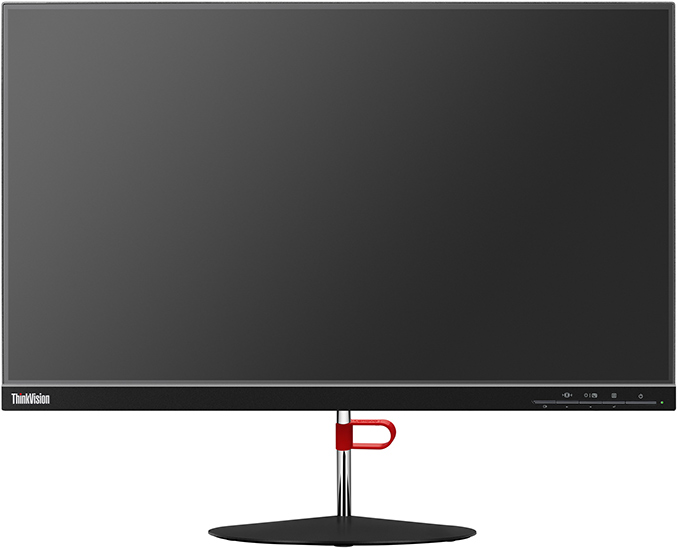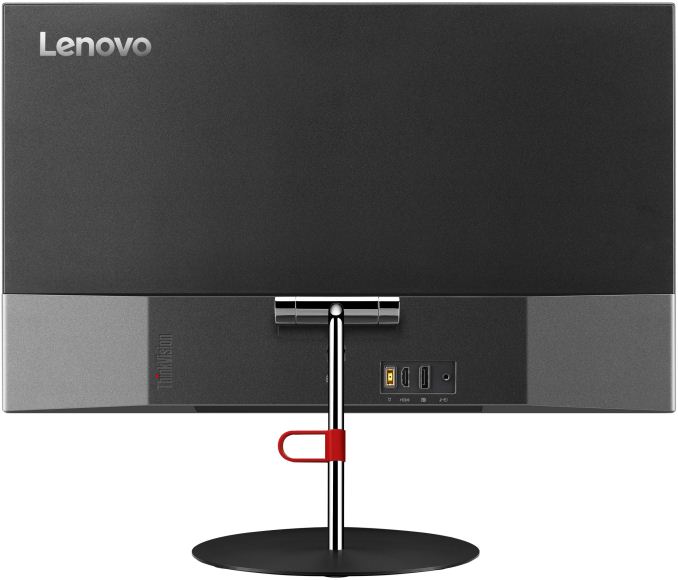Lenovo Unveils New ThinkVision X24 LCD: 4-mm Thick, Ultra-Thin Bezels, FHD, IPS
by Anton Shilov on January 5, 2018 1:30 PM EST- Posted in
- Displays
- Lenovo
- IPS
- Monitors
- ThinkVision
- FHD
- ThinkVision X24

Ahead of next week's CES show, Lenovo this morning is taking the wraps off of one of their thinnest and lightest 23.8” FHD displays to date, the Lenovo ThinkVision X24. The ThinkVision X24 is aimed primarily at business users as it has a rather strict yet elegant design and an antiglare coating, while the technical specifications of the display itself are rather typical for a budget monitor. That said, the monitor comes with a panel capable of representing 96% of the sRGB spectrum, which is a wider gamut than what we usually see for a low-priced ultra-thin model.
The main selling points of the new Lenovo ThinkVision X24 are its compact design as well as ultra-thin bezels. The display itself is just 4 mm thick at its narrowest points, but due to integrated connectivity hub and other electronic components, its lower/bottom part is considerably thicker. The previous-generation ThinkVision X24 was 7.5 mm thick at its narrowest, so the new model should look a bit sleeker. When it comes to bezels, Lenovo advertises them at 1.1 mm, but what it means are essentially plastic sides of the chassis. The actual bezels (frames) of the panel are wider, but they are still very thin when compared to mainstream monitors.
Moving on to general specs. The Lenovo ThinkVision X24 uses a 23.8” IPS panel with a 1920×1080 resolution, a 250 nits brightness, a 1000:1 contrast ratio, and 178°/178° viewing angles. The monitor can display 96% of the sRGB color gamut, which is rather good for an ultra-thin model. The new ThinkVision X24 also cuts down its minimal response time in fast mode down to 4 ms, which is not going to impress gamers, but it is good enough for a business monitor.
As for connectivity, everything looks pretty standard here: a DisplayPort 1.2, an HDMI 1.4 input as well as a 3.5-mm audio jack output. The display lacks USB Type-C connectivity or a built-in USB hub, so it is not going to provide a maximum comfort for owners of the latest ultra-thin laptops with the aforementioned ports by offering them one-cable-for-everything connectivity. Speaking of comfort, the adjustment buttons of the display are now located on the front panel, making it easier to fine-tune it. As for ergonomics, the 2018 ThinkVision X24 features a stand that can adjust tilt, but not height, swivel or pivot. Meanwhile, since the stand can be detached, Lenovo might offer a special VESA mount for those who need to use multiple X24s and adjust everything they need.
| Specifications of Lenovo's 2018 ThinkVision X24 Display | ||
| ThinkVision X24 2018 | ||
| Panel | 23.8" IPS | |
| Native Resolution | 1920 × 1080 | |
| Maximum Refresh Rate | 60 Hz | |
| Response Time (Grey-to-Grey) | 4 ms in fastest mode 6ms in fast mode 14 ms in normal mode |
|
| Brightness | 250 cd/m² | |
| Contrast | 1000:1 | |
| Viewing Angles | 178°/178° horizontal/vertical | |
| Pixel Pitch | 0.2744 × 0.2744 mm | |
| PPI | 92 | |
| Color Gamut | 99% sRGB | |
| Inputs | 1 × HDMI 1 × DisplayPort |
|
| Audio | 3.5-mm headphone jack | |
| Color | Black and grey | |
| Power Consumption | Standby | unknown |
| Maximum | unknown | |
Lenovo plans to start selling the new ThinkVision X24 in the USA in January. The new unit will cost $249 in retail.
Related Reading:
- Lenovo Launches New ThinkPad Accessories: Docking And Displays
- AOC’s Entry-Level C2789FH8 27” Display Weds Gold, Bling, and Curvature
- AOC Teams Up with Porsche Design for PDS241 and PDS271 Displays
- The AOC Q2781PS Announced: 'Frameless' Rose Gold 27" QHD with Swarovski Crystals
- Lenovo Announces New ThinkStation P520/P520C and ThinkPad 52s: Up to 18 Core Xeon-W, Quadro Graphics
- Lenovo Launches Yoga 920 Convertible: 13.9” 4K LCD, 8th Gen Core i7, TB3, 3 Pounds
- Lenovo Unveils ThinkStation P320 Tiny SFF Workstation
- Lenovo Updates ThinkStation P320 with Intel Xeon E3 v6 and NVIDIA Quadro Pascal


















6 Comments
View All Comments
Morawka - Friday, January 5, 2018 - link
Without a VESA mount, or the option to purchase one, this monitor is kind of a non-starter for business in my opinion. Desk space is crucial in the office work environment. Hopefully Lenovo releases an adapter in what seems like a nice design with signature Lenovo design cues such as the textured finish and red cable management loop. I do like the Hinge, but I also want o see VESA mounting holes, even if you have to plug them.Kaggy - Friday, January 5, 2018 - link
That's what I thought as well.Without VESA mount this is not business friendly.
CaedenV - Sunday, January 7, 2018 - link
Agreed; My setup at work is a 0-client with 4 monitors in a 2x2 config... would love to have something with slimmer bezels, but not going to happen with something like this.etamin - Friday, January 5, 2018 - link
Really wish Lenovo of all companies would come out with WUXGA panels for productivity. FHD has no place in business applications.DanNeely - Saturday, January 6, 2018 - link
Your pointy haired boss disagrees. He's been running the big high DPI screens you've been denied by purchasing since 1920x1200 was king at 1280x1024 because the bigger text is easier on his half-blind eyes while submitting bug reports about your software having everything stretched into weird proportions.The latter happened to me, I tried to convince him to run at 1680x1050 or 1440x900 to avoid aspect ratio distortion (we were on XP at the time so DPI scaling would've been even worse) but he always kept going back to a 5:4 resolution and complaining about how nothing looked right.
galfert - Saturday, January 6, 2018 - link
This is not new. This monitor came out in 2015.